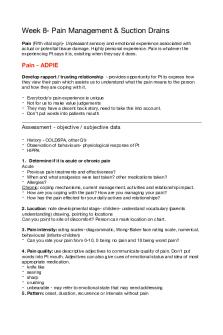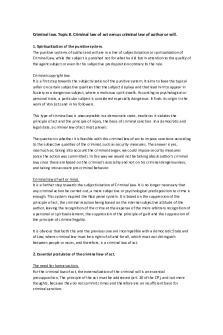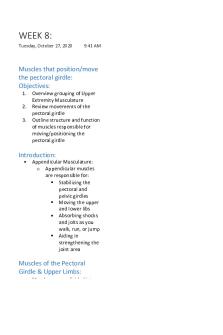Graded Potentials - Lecture notes 8 PDF

| Title | Graded Potentials - Lecture notes 8 |
|---|---|
| Course | Human Anatomy and Physiology with Lab II |
| Institution | The University of Texas at Dallas |
| Pages | 1 |
| File Size | 49.7 KB |
| File Type | |
| Total Downloads | 78 |
| Total Views | 148 |
Summary
Graded Potentials...
Description
Graded Potentials Any stimulus that opens a gated channel produces a graded potential. Graded potentials, or local potentials, are changes in the membrane potential that cannot spread far from the site of stimulation. Figure 12–11 shows what happens when the plasma membrane of a resting cell is exposed to a chemical that opens chemically gated sodium ion channels: 1) Sodium ions enter the cell and are attracted to the negative charges along the inner surface of the membrane. As these additional positive charges spread out, the membrane potential shifts toward 0 mV. Any shift from the resting membrane potential toward a less negative potential is called a depolarization. Note that this term applies to both changes in potential from -70 mV to lesser negative values 1 -65 mV, -45 mV, -10 mV2, as well as to membrane potentials above 0 mV 1 +10 mV, +30 mV2. In all these changes, the membrane potential becomes more positive. 2)As the plasma membrane depolarizes, sodium ions are released from its outer surface. These ions, along with other extracellular sodium ions, then move toward the open channels, replacing ions that have already entered the cell. This movement of positive charges parallel to the inner and outer surfaces of a membrane that spreads the depolarization is called a local current. In a graded potential, the degree of depolarization decreases with distance away from the stimulation site; in other words, the local current dissipates. Why? Depolarization lessens with distance because the cytosol offers considerable resistance to ion movement, and because some of the sodium ions entering the cell then move back out across the membrane through sodium leak channels. At some distance from the entry point, the effects on the membrane potential are undetectable. The maximum change in the membrane potential is proportional to the size of the stimulus, which determines the number of open sodium ion channels. The more open channels, the more sodium ions enter the cell, the greater the membrane area affected, and the greater the degree of depolarization. When the chemical stimulus is removed and normal membrane permeability is restored, the membrane potential soon returns to the resting level. The process of restoring the normal resting membrane potential after depolarization is called repolarization (Figure 12–12). Repolarization typically involves a combination of ion movement through membrane channels and the activities of ion pumps, especially the sodium–potassium exchange pump. However, if a gated potassium ion channel opens in response to a stimulus, the opposite effect occurs. The rate of K+ outflow increases, and the interior of the cell loses positive ions. In other words, the inside of the cell becomes more negative. The loss of positive ions produces hyperpolarization, an increase in the negativity of the resting membrane potential, for example, from -70 mV to perhaps -80 mV or more (see Figure 12–12). Again, a local current distributes the effect to adjacent portions of the plasma membrane, and the effect decreases with distance from the open channels. Table 12–2 summarizes the basic characteristics of graded potentials...
Similar Free PDFs

8 - Lecture notes 8
- 21 Pages

8 - Lecture notes 8
- 21 Pages

8 Midwifery - Lecture notes 8
- 3 Pages

Taxation 8 - Lecture notes 8
- 2 Pages

Week 8 - Lecture notes 8
- 6 Pages

Dox 8 - Lecture notes 8
- 21 Pages

Lesson 8 - Lecture notes 8
- 2 Pages

Assignment 8 - Lecture notes 8
- 4 Pages

Week 8 - Lecture notes 8
- 23 Pages

WEEK 8 - Lecture notes 8
- 10 Pages

CL-8 - Lecture notes 8
- 12 Pages

Tema 8 - Lecture notes 8
- 8 Pages

Lesson 8 - Lecture notes 8
- 19 Pages

Chapter 8 - Lecture notes 8
- 7 Pages
Popular Institutions
- Tinajero National High School - Annex
- Politeknik Caltex Riau
- Yokohama City University
- SGT University
- University of Al-Qadisiyah
- Divine Word College of Vigan
- Techniek College Rotterdam
- Universidade de Santiago
- Universiti Teknologi MARA Cawangan Johor Kampus Pasir Gudang
- Poltekkes Kemenkes Yogyakarta
- Baguio City National High School
- Colegio san marcos
- preparatoria uno
- Centro de Bachillerato Tecnológico Industrial y de Servicios No. 107
- Dalian Maritime University
- Quang Trung Secondary School
- Colegio Tecnológico en Informática
- Corporación Regional de Educación Superior
- Grupo CEDVA
- Dar Al Uloom University
- Centro de Estudios Preuniversitarios de la Universidad Nacional de Ingeniería
- 上智大学
- Aakash International School, Nuna Majara
- San Felipe Neri Catholic School
- Kang Chiao International School - New Taipei City
- Misamis Occidental National High School
- Institución Educativa Escuela Normal Juan Ladrilleros
- Kolehiyo ng Pantukan
- Batanes State College
- Instituto Continental
- Sekolah Menengah Kejuruan Kesehatan Kaltara (Tarakan)
- Colegio de La Inmaculada Concepcion - Cebu

